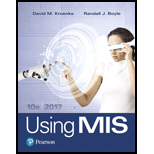
Using MIS (10th Edition)
10th Edition
ISBN: 9780134606996
Author: David M. Kroenke, Randall J. Boyle
Publisher: PEARSON
expand_more
expand_more
format_list_bulleted
Expert Solution & Answer
Chapter 1.7, Problem 7ARQ
Explanation of Solution
Trends expected in 2027:
By 2027, there will be a huge rise in the Artificial Intelligence and hence demand for AI related jobs will be huge in the market.
Biotechnology:
The Biotechnology department is blooming and with more researches going on, by 2027 the market and demand for Biotechnology related jobs will be huge.
- Huge increase in software developer jobs as their will be a great increase in number of robots and demand for developers will be high.
- Due to the emerging techniques such as augmented reality and virtual reality, by 2027, the demand for alternative reality architect will be high to research, write and design the virtual augmentation.
- By 2027, the demand for urban farmer will be high.
- With more uses of drone in future, drone dispatcher and remote drone driver job will be in demand in 2027.
Use of Smartphone in 2027:
- With development in technology, due to the advancement in augmented reality, Smartphone might get replaced with devices that can project holograms and use technologies such as Alexa, Siri and Echo will be huge.
- More compact and smaller size phones will be in use in 2027 and the storage capacity will be huge and smart phones will use all the new technologies available.
Devices that might be able to connect to internet in 2027 will be smart phones, watches, cars, house automation system and many others...
Expert Solution & Answer
Want to see the full answer?
Check out a sample textbook solution
Students have asked these similar questions
Please answer the question correctly please. Thank you!!
Please answer the question correctly please. Thank you!!
Please answer the question correctly please. Thank you!!
Chapter 1 Solutions
Using MIS (10th Edition)
Ch. 1.4 - Prob. 1AAQCh. 1.4 - Prob. 2AAQCh. 1.4 - Prob. 3AAQCh. 1.4 - Prob. 4AAQCh. 1.7 - Prob. 1EGDQCh. 1.7 - Prob. 2EGDQCh. 1.7 - Prob. 3EGDQCh. 1.7 - Prob. 4EGDQCh. 1.7 - Prob. 5EGDQCh. 1.7 - Prob. 6EGDQ
Ch. 1.7 - Prob. 7EGDQCh. 1.7 - Prob. 8EGDQCh. 1.7 - Prob. 1SGDQCh. 1.7 - Prob. 2SGDQCh. 1.7 - Prob. 3SGDQCh. 1.7 - Prob. 4SGDQCh. 1.7 - Prob. 5SGDQCh. 1.7 - Prob. 1CGDQCh. 1.7 - Prob. 2CGDQCh. 1.7 - Prob. 3CGDQCh. 1.7 - Prob. 4CGDQCh. 1.7 - Prob. 1ARQCh. 1.7 - Prob. 2ARQCh. 1.7 - Prob. 3ARQCh. 1.7 - How can you use the five-component model? Name and...Ch. 1.7 - Prob. 5ARQCh. 1.7 - Prob. 6ARQCh. 1.7 - Prob. 7ARQCh. 1 - Prob. 1.1UYKCh. 1 - Prob. 1.2UYKCh. 1 - Prob. 1.3UYKCh. 1 - Prob. 1.4CE1Ch. 1 - Prob. 1.5CE1Ch. 1 - Prob. 1.6CE1Ch. 1 - Prob. 1.7CE1Ch. 1 - Prob. 1.8CE1Ch. 1 - Prob. 1.9CS1Ch. 1 - Prob. 1.1CS1Ch. 1 - Prob. 1.11CS1Ch. 1 - Prob. 1.12CS1Ch. 1 - Prob. 1.13CS1Ch. 1 - Prob. 1.14CS1Ch. 1 - Prob. 1.15MML
Knowledge Booster
Similar questions
- Considering the TM example of binary sum ( see attached)do the step-by-step of execution for the binary numbers 1101 and 11. Feel free to use the Formal Language Editor Tool to execute it; Write it down the current state of the tape (including the head position) and indicate the current state of the TM at each step.arrow_forwardI need help on inculding additonal code where I can can do the opposite code of MatLab, where the function of t that I enter becomes the result of F(t), in other words, turning the time-domain f(t) into the frequency-domain function F(s):arrow_forwardI need help with the TM computation step-by-step execution for the binary numbers 1101 and 11. Formal Language Editor Tool can be used to execute it; Write it down the current state of the tape (including the head position) and indicate the current state of the TM at each step;arrow_forward
arrow_back_ios
SEE MORE QUESTIONS
arrow_forward_ios
Recommended textbooks for you
 Principles of Information Systems (MindTap Course...Computer ScienceISBN:9781305971776Author:Ralph Stair, George ReynoldsPublisher:Cengage Learning
Principles of Information Systems (MindTap Course...Computer ScienceISBN:9781305971776Author:Ralph Stair, George ReynoldsPublisher:Cengage Learning Information Technology Project ManagementComputer ScienceISBN:9781337101356Author:Kathy SchwalbePublisher:Cengage Learning
Information Technology Project ManagementComputer ScienceISBN:9781337101356Author:Kathy SchwalbePublisher:Cengage Learning Fundamentals of Information SystemsComputer ScienceISBN:9781337097536Author:Ralph Stair, George ReynoldsPublisher:Cengage Learning
Fundamentals of Information SystemsComputer ScienceISBN:9781337097536Author:Ralph Stair, George ReynoldsPublisher:Cengage Learning Fundamentals of Information SystemsComputer ScienceISBN:9781305082168Author:Ralph Stair, George ReynoldsPublisher:Cengage Learning
Fundamentals of Information SystemsComputer ScienceISBN:9781305082168Author:Ralph Stair, George ReynoldsPublisher:Cengage Learning Principles of Information Systems (MindTap Course...Computer ScienceISBN:9781285867168Author:Ralph Stair, George ReynoldsPublisher:Cengage Learning
Principles of Information Systems (MindTap Course...Computer ScienceISBN:9781285867168Author:Ralph Stair, George ReynoldsPublisher:Cengage Learning

Principles of Information Systems (MindTap Course...
Computer Science
ISBN:9781305971776
Author:Ralph Stair, George Reynolds
Publisher:Cengage Learning

Information Technology Project Management
Computer Science
ISBN:9781337101356
Author:Kathy Schwalbe
Publisher:Cengage Learning

Fundamentals of Information Systems
Computer Science
ISBN:9781337097536
Author:Ralph Stair, George Reynolds
Publisher:Cengage Learning

Fundamentals of Information Systems
Computer Science
ISBN:9781305082168
Author:Ralph Stair, George Reynolds
Publisher:Cengage Learning

Principles of Information Systems (MindTap Course...
Computer Science
ISBN:9781285867168
Author:Ralph Stair, George Reynolds
Publisher:Cengage Learning
